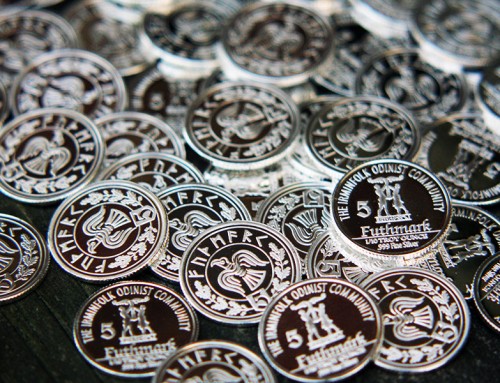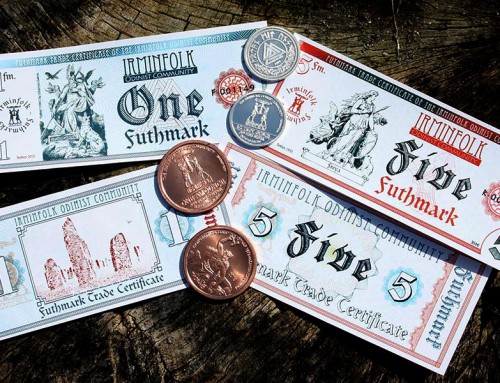
A few years ago, I commissioned a master sword-maker in Europe to make me a Petersen type H, late Migration era “viking” sword. It was lucky timing that I purchased my sword when I did because that same year, he stopped making custom swords for private individuals and began exclusively selling to museums. But there was another reason the timing was right to buy the sword when I did: the dollar was at the beginning of a steep decline against the Pound and the Euro.
Paul, the swordmaker, had given me the option to pay up front, or to wait until the sword was finished to pay him. I decided that since I had the cash on me, I’d pay the 800 Great Britain Pounds he quoted me immediately. Then I waited. Every few months he’d call me or write me and ask me to measure the width of my hand, or the distance from my thumb to the floor while standing, or stuff like that. It wasn’t until fully 18 months later that the sword arrived and I was very excited to show it off. My first conversation about the sword went something like this:
me: ” This ain’t like one of those $50 mall swords”
Friend: ” Really? How much was it?”
me: “like 800 pounds”
friend: “How much is that in dollars?”
me: “just shy of a grand.”
friend: “ummm, no it ain’t, 800 pounds is almost 1600 dollars”
At that moment my thoughts went to the safe I had in my bedroom that had been stacked with $20 bills; my version of a bank account since I could find no compelling reason I should give someone else my money for storage. I suddenly realized that the entire previous year of hording my pay from my stockboy job at staples was literally “going bad” like over ripe bananas the longer I sat on it. I had to get rid of these perishable Federal Reserve Notes and quick. I immediately thought of buying precious metals.
I knew nothing at all about investing – nothing – so I made my first investment with only a fraction of my rapidly spoiling fiat currency. I thought I would buy some gold because that’s what I was always hearing about. But Gold was over 500 dollars for each coin! There was a really awesome platinum coin I wanted with a Viking ship on it, but it was even more expensive than gold. I felt that Gold and Platinum were too concentrated a store of wealth. If one day I wanted to sell it, and there was a great depression, who could afford to buy it from me?
So I decided on Silver, which was almost up to 9 dollars an ounce at the time. With the “what if I have to make change in Mad Max’s barter town one day” scenario in mind, I bought several dozen one ounce “rounds” and several dozen one ounce bars. I bought just enough so that the price break equated to free shipping.
Several weeks had passed and I still had not gotten my delivery, but Silver had climbed up to 12.75 an ounce. So I went all in and scraped all but the last bit of decaying greenbacks off their steel shelf and sent them off. This time I bought some bulkier silver bars: a few 10 ouncers and a bunch of 5 ouncers.
By the time I actually received the shipment, the spot price of silver had climbed up to 17 an ounce and then, a few months later, $25 an ounce.
So compelling was the evidence that I had made a good decision hastily, that I went and did the research which I probably should have done in the first place. This is what I gleamed from the experience:
Disclaimer: I am not some finance guru. Your mileage may, and probably will, vary if you decide to take this article as advice. If a mile-wide sterling silver asteroid falls from the sky and lands on the White House, driving the value of your silver investment down lower than the price of dirt, don’t blame me. This is not advice; just an anecdote about my experience.
-

Paper money has no intrinsic value, it is not “wealth” any more than a ruler is height. It is exactly the opposite of wealth, it is “evidence of debt”.
This should go without saying, but it is worth mentioning. Always buy physical silver that you hold in your hand. There is very little difference between owning a “warehouse receipt” or “promissory note” or any other form of “paper silver” than there is to owning paper dollars from the Federal reserve. They have NO intrinsic value. A paper note is “evidence of debt”, not wealth. It says so right on the front: “this note is legal tender for all DEBT…” (emphasis added). Recently the Federal Government raided a warehouse and stole millions of ounces of silver from a company called Norfed. Thousands of people had purchased “warehouse receipts” on that silver and now the best they can do is sell the notes on ebay as curiosity items. (Not me tho, I have actual silver Norfed coins). That is an extreme case, but another very important reason to buy physical silver and not paper silver is that you don’t know how many other people also bought your single share of precious metal, or that there even ever WAS any metal in the first place!
- Precious metals, such as silver, are commodities and they track with other commodities on the stock market. Like stocks, metals have a “bid” and “ask” price. The Bid price is the amount you can sell the commodity for and the ask price is how much you have to pay to get it. This is what is known as “spot price”. The bid price is always lower than the Ask (spot) price.
But thats not all there is to it. Imagine if an ounce of old silver spoons from a yard sale was the same price as a rare coin in mint condition? No, there is always a premium over spot price. This premium is based on the quality, rarity, condition, demand, quantity of metal you buy, and how greedy the seller is feeling that day.
So, you might see an advertisement thats reads: “One oz Silver Eagles only $3.99 over spot”. This means they are selling a one troy ounce .999 pure silver United States Dollar coin for whatever the spot price happens to be at the exact moment of your transaction, plus $3.99 for their cut. They are in the retail business after all.
There is a huge difference between “coins” and “rounds”, even if they look essentially the same. A coin is a sovereign instrument of debt issued by a Government. Examples are Silver Eagles, Morgan Dollars, Chinese Pandas, Australian Kookaburras, South African Krugerrands, and Austrian Philharmonics, to name a few. They are not always pure; Often they are alloyed with copper or nickel to make them more durable for circulation. Do a little bit of research on the precious metal content of a “coin” if you are unfamiliar with it. The spot price applies to the precious metal weight only, not the overall weight of the alloyed coin.
“Rounds” are flat round disks of precious metals with pictures on both sides, just like a coin. The only difference is that it is not an instrument of debt – not legal tender. Instead of a dollar amount, it says how pure it is and how much it weighs. They should be stamped something like: one Troy ounce of .999 pure silver.
Of course, precious metals come in bars too. You can get anything from a gram sized Gold bar to a 10 kilo slab of silver and anything in between.- There are generally 2 places to buy precious metals: from a coin shop or off the internet. There are advantages and pitfalls to both. In a brick and mortar store, you get to physically see exactly what you are getting and may inspect the product before you buy. You also get to skip paying shipping and handling. Usually, this is a great option if you happen to have a coin shop within a reasonable distance. A shop usually does less volume than some of the internet establishments and so you might not have as vast a selection or quantity you might be looking for. Also, you are locked in at the price that silver happens to be at when it is convenient for you to get to their store.
The second option is the internet. Online Stores such as Apmex are highly reputable and have a huge selection. You do have to pay shipping, so factor that in in your investment. If you spend enough, however, the shipping cost is dropped by the price breaks. When purchasing online, it is a considerable savings to pay with a money order as opposed to paying with a credit card because they have to pass on the Credit Card company’s percentage per transaction charge to you.
Lastly, there is Ebay. Ebay is the wild west. I have gotten super awesome deals on silver coins off ebay, but I have also seen some really shady dealings on there.
Burning money to keep warm. Imagine how many trillions of marks an ounce of silver could have bought, That’s like a weeks worth of heat!
I invested in silver as a hedge against the end of the world, not as a short term investment. I don’t try to buy silver at such and such price point and then “day trade”. Silver is a very volatile metal in terms of it’s value. It can drop $10 an ounce in one day or it can ratchet up to $50 just to drop down again. Each time they killed Osama the markets dropped again, then the stark reality that debt is not wealth comes back to haunt wall street and precious metals are high in demand again. I’m sure there’s plenty of room in such a market for smart money witchdoctors to exploit. I don’t do that; I have too many hobbies already. I put all my loose change in a jar and whenever prices “correct” down temporarily, I buy with both fists. All I know is that each time there is a buying opportunity, the prices are higher than the last buying opportunity a few months earlier. As little as 2 years ago you’d be laughed at if you said that silver would hit $80 an ounce, now you can read about these predictions right from wall street.
- This is just my observation from tracking the silver market for the past few years: I have noticed that the prices of silver seem to be a little bit lower on a Monday morning, and tend to close a bit higher on a Friday. You can download an app for your phone and watch precious metal prices and tell me if I am just crazy.
- “How do I cash in the silver when I need the money?”
Companies like Apmex and almost all coin shops will buy back precious metals. You can also try selling on Ebay and collect a few extra dollars off shipping on each transaction. Or, if dollars are no longer in fashion, you can barter your silver for things you want.
- Precious metals, such as silver, are commodities and they track with other commodities on the stock market. Like stocks, metals have a “bid” and “ask” price. The Bid price is the amount you can sell the commodity for and the ask price is how much you have to pay to get it. This is what is known as “spot price”. The bid price is always lower than the Ask (spot) price.







